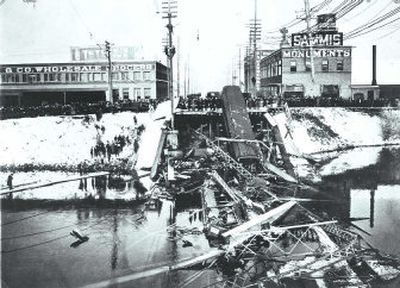Disaster on Division

A sleepy bunch of Spokane workmen were riding the Astor streetcar to work at 6 a.m. on Dec. 18, 1915, when, suddenly, the Division Street Bridge collapsed violently beneath them. The deck, the tracks and the streetcar itself splashed into the frigid waters of the Spokane River. It was one of the worst accidents in Spokane’s history, killing five men and injuring 12. It was not only the icy water that killed the men. A steel girder from the bridge’s superstructure came slashing down, shearing the top off of the streetcar and killing several of the passengers sitting on the left side of the car and pinning most of the others. One survivor, the owner of the Pend Oreille Bar, said he found himself submerged and had to struggle to get his head above water. “As I was trying to climb out the car window, someone down in the car grabbed me by the feet and nearly pulled me back,” said the saloon owner. “His hold was finally released and I was able to climb on out. The screams of those pinned down there in the car were awful. I was the last man out of the car alive.”
“I tried to crawl out the top of the car,” the motorman of the Astor streetcar said in the hospital that night. “When I found I could not get out through the roof of the cab, I managed to get back and crawled up on top of the car where it seemed the majority of the people were. There was lots of yelling and it was dark. … I started to creep up on my hands and knees, but when I put my hand down, I felt it give way and then for the first time discovered my wrist was broken.”
Another survivor, identified in the next day’s Spokesman-Review as “a colored employee of the Dornberg Jewelry Company,” said, “At first we didn’t know where we were and I thought we had just run off the track onto the pavement. Then the water began to come through the windows and I knew we had tumbled into the river. A man sitting next to me broke a window and climbed out and I did the same. We yelled for about 15 minutes before anyone came.”
Fire and rescue crews came as soon as they could, but their efforts were hampered by the fact that the bridge carried live electric lines, water lines and gas lines, all of which were broken and tangled in the wreckage.
The Astor motorman recalled that one of the first things he heard amidst the initial chaos was one passenger shouting, “My God, it might have been worse.”
He was right, although he couldn’t have known it at the time. A second streetcar, the Hillyard car, was also crossing the bridge. It had nearly made it onto solid land when the deck collapsed. The car was dragged backwards and down, so that only the front wheels were left on the track above. The rear of the car went down with the collapsed deck, leaving the car at a perilous angle.
“The car was standing nearly on end and I, with the passengers, climbed up the aisle using the seats as steps and crawled out the front end,” said the Hillyard conductor. “No one in the car was hurt much.”
Only two passengers were on board the Hillyard car. None of the passengers on either car were women.
The repercussions of the accident were felt throughout the city.
“Probably no disaster locally has caused so general an upheaval,” reported the S-R. “The mains and electricity wires across the river at Division street serve a great portion of the North Side and there was widespread confusion when hundreds of homes suddenly found themselves without water, gas, electric light or telephone service.”
An investigation into the cause of the collapse began immediately. Engineers testified that some of the key steel pieces showed signs of “granulation” or metal fatigue. The New York engineer who designed the bridge in 1892 examined the wreckage and blamed it on damage from the 1894 flood, in which a washed-away railway span floated downstream and “struck the specific bars that broke” in the accident. However, no definitive cause was ever determined.
The city eventually came to the conclusion that (in the words of an S-R editorial) “steel bridges are in the past era; we are in the age of concrete.” A concrete span was finished in 1917.